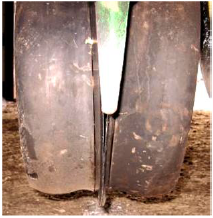- Regardless of the brand of planter or the type of seed metering device it incorporates, manufacturers suggest it be checked for proper and accurate functioning prior to the planting season.
- Problems can be identified and appropriate maintenance and repairs can be made without the stress of an in-season remedy.
- The cost of planter maintenance is usually comparatively low, with a payback in peace of mind and potentially higher yields.
Benefits
The benefits of following the manufacturer’s recommendation for pre-season maintenance and calibration include the following:1
- Decreased in-season downtime.
- Better ability to achieve accurate and desired seed-drop.
- A likely improvement in plant-to-plant spacing in a row.
- A possibility of improved yield potential.
Rate of Seed Delivery
When considering the speed at which planter seed metering units need to dispense seed, it is pretty amazing. A planter moving at 5 miles per hour (7.3 feet per second), dropping a planting population of 38,000 seeds per acre in 30-inch rows (1 seed about every 5.4 inches), needs to deliver about 16 to 17 seeds per second. It is easy to see why all the mechanisms need to be finely tuned and working well.
Planter Maintenance
Properly maintaining your planter is critical to optimizing yield potential. Always refer to the manufacturer’s manual before performing any maintenance. Some general planter maintenance concepts and their potential effects on the crop are discussed below.
Drives that are not properly maintained can cause uneven plant spacing. Common items that may be included in your operator’s manual as part of planter drive maintenance may include:2
- Worn chains, stiff chain links, and tire pressure.
- Lubrication of chains and fittings.
- Alignment of drive sprockets and meter drive couplers (i.e. flippers or dogs).
- Proper planter transmission sprocket settings.
Row Unit maintenance can affect uniformity of plant stand and emergence. Common items that may be included in your operator’s manual as part of row unit maintenance may include:2
- Proper down force and planter frame height across the planter, which can help achieve good soil penetration.
- Proper settings for residue managers, which can help achieve good seed to soil contact.
- Alignment of coulters and disc openers.
- Adjustment of coulter down pressure and depth to help with good seed to soil contact.
- Recommended amount of contact between double disk openers, commonly 1.5 to 2.5 inches (Figure 1).
- Seed tubes and sensor cleaning. Objects in seed tubes can interrupt uniform seed drop.
- Proper alignment of closing wheels over furrow.

Meters that are properly maintained can help contribute to uniform seed spacing. Common items that may be included in your operator’s manual as part of meter maintenance may include:2
- Annual testing and calibration of finger pickup meters. Wear on the back plate and brushes, or improper tension on the fingers, may result in poor seed placement within the row.
- Seal integrity, baffle settings, brush quality, and disc contact with the housing for vacuum meters.
Seed Size and Treatments can affect planter settings. Refer to the owner’s manual for recommendations on the use of lubricants such as talc and graphite, and adjustments to vacuum settings. Match the seed size with the disc and vacuum pressure recommended.
Tips for Getting Your Planter Ready to Go
Below are some general manufacturer’s tips for checking a planter:
- Unit should be cleaned, inside and out.
- Seed meters or seed drop tubes should be free from anything that interferes with their operation.
- Worn parts should be replaced.
- Worn disc openers should be adjusted or replaced.
- Coulters and disc openers should be aligned.
- Worn seals on drums or vacuum discs should be replaced.
- Finger pick-up back plates should be checked for rust, residue, and worn-down dimples.
- Seed tube should be cleaned and replaced if excessively worn at bottom.
- Monitor sensors should be cleaned.
- Seed conveyor belt should be checked for brittleness and replaced if needed.
- Chains should be lubricated and replaced if worn excessively.
- Tires should be checked for proper inflation and significant wear.
Always refer to the manufacturer’s manual before performing any maintenance.
Summary
Uneven stand establishment can reduce corn yield potential by 7 to 15 bushels per acre.1 Taking the time to perform planter maintenance before the planting season begins can help decrease both emergence and within-row plant spacing variability and help to maximize yield potential.
Sources
1Nielsen, R. 2000. Planter maintenance, there’s still time. Purdue University. http://www.agry.purdue.edu.
2Nielsen, R. 2001. Stand establishment variability in corn. Purdue University. AGRY- 91-01. http://www.agry.purdue.edu.
3Hoeft, R. and E. Nafziger. 2002. Illinois Agronomy Handbook, 23rd Edition. University of Illinois Extension.
Web sources verified 11/30/2015. 130809060643
